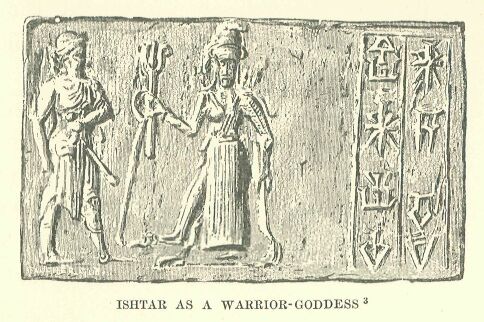Syncretic Istar
“But who, all this while, was the goddess, whom one legend made the faithful wife enduring even death for her husband’s sake, while another regarded her as the most faithless and cruel of coquettes?
I have already spoken of her as the goddess of love, and such, indeed, she was to the Babylonian or Assyrian of later days. In the story of her descent into Hades, her residence in the lower world is marked by all cessation of intercourse between male and female in the animal creation, as well as among the gods of heaven.
It was this feature of the story which caused it to find its way into the literature of another people, and to survive the days when the clay tablets of Assyria and Babylon could still be read. We find it serving to point a moral in the pages of the Talmud.
We are there told how a pious rabbi once prayed that the demon of lust should be bound, and how his petition was granted. But society quickly fell into a state of anarchy. No children were born; no eggs even could be procured for food; and the rabbi was at length fain to confess that his prayer had been a mistaken one, and to ask that the demon should again be free.
But though a moral signification thus came to be read into the old Babylonian myth, it was a signification that was originally entirely foreign to it. Prof. Tiele has clearly shown that the legend of Istar’s descent into Hades is but a thinly-veiled description of the earth-goddess seeking below for the hidden waters of life, which shall cause the Sun-god and all nature with him to rise again from their sleep of death.

Drawn by Faucher-Gudin, from an intaglio at Rome.
http://www.gutenberg.org/files/17323/17323-h/17323-h.htm#linkBimage-0018
The spirits of earth, the gnomes that guard its treasures below, watch over the waters, and not until they are led forth and placed on their golden throne can their precious treasure be secured. It is the earth who loses her adornments, one by one, as she passes slowly downward into the palace-prison of the infernal goddess, and it is the earth who is once more gladdened at spring-time with the returning love of the youthful Sun-god.
Istar, then, must primitively have been the goddess of the earth, and the bride of Tammuz at Eridu must accordingly have been his mother Dav-kina. This alone will explain the persistent element in the myth as it made its way to the Greeks, according to which the mother of Tammuz was also his sister.
Istar, Tillili, Dav-kina, were all but different names and forms of the same divinity. We have just seen that Tillili, at all events, was the primordial earth.

Drawn by Faucher-Gudin, from a heliogravure in Ménant’s Recherches sur la Glyptique orientale.
http://www.gutenberg.org/files/17323/17323-h/17323-h.htm#linkBimage-0018
What Istar was primitively, however, will not explain what she became in those later ages of Babylonian history to which our monuments belong. Her origin faded more and more into the background; new elements entered into her character; and she absorbed the attributes and functions of numberless local divinities. The Istar of Assur-bani-pal or Nabonidos was the inheritress of cults and beliefs which had grown up in different localities and had gathered round the persons of other deities.”
A.H. Sayce, Lectures on the Origin and Growth of Religion as Illustrated by the Religion of the Ancient Babylonians, 5th ed., London, 1898, pp. 250-2.
